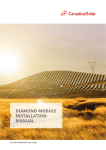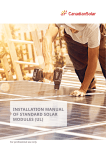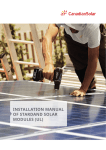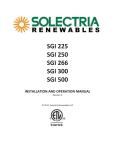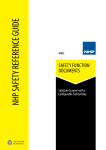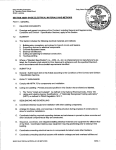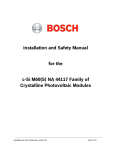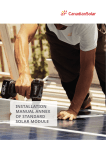Download DIAMOND MODULE INSTALLATION MANUAL
Transcript
DIAMOND MODULE INSTALLATION MANUAL For professional use only EN-Rev IM-DM-EN/1.1 Copyright © Feb. 2015. Canadian Solar Inc. 1.0 |4 GENERAL INFORMATION 1.1 INSTALLATION MANUAL DISCLAIMER |4 1.2 LIMITATION OF LIABILITY |4 2.0 SAFETY PRECAUTIONS |4 3.0 |5 MECHANICAL / ELECTRICAL SPECIFICATIONS 4.0 UNPACKING AND STORAGE |5 5.0 MODULE INSTALLATION |6 5.1 MODULE WIRING |7 5.2 MODULE GROUNDING |8 6.0 MOUNTING INSTRUCTIONS |8 6.1 RECOMMENDED METHOD: CLAMPING |9 7.0 |10 MAINTENANCE AMENDED EDITIONS AND DATES |10 ANNEX A: MODULE SPECIFICATION |11 www.canadiansolar.com 4 | 1.0 GENERAL INFORMATION irrespective of whether or not the module and the This general manual provides important safety GENERAL SAFETY other electrical equipment have been connected. information relating to the installation, maintenance and handling of double glass solar modules. · All modules must be installed by licensed electricians Professional installer must read these guidelines in accordance with the applicable electrical codes carefully and strictly follow these instructions. such as, the latest National Electrical Code (USA) or Failure to follow these instructions may result in Canadian Electric Code (Canada), or other national death, injury or property damage. The installation or international electrical codes. and handling of PV modules requires professional skills and should only be performed by qualified Protective clothing (non-slip gloves, professionals. The installers must inform end -users clothes, etc.) must be worn during (consumers) the aforesaid information accordingly. installation to prevent direct contact The word "module" or "PV module" used in this with 30 VDC or greater, and to protect manual refers to one or more CS-series solar modules. your hands from sharp edges. Please retain this manual for future reference. We recommend checking www.canadiansolar.com Prior to installation, remove all metallic regularly for the most updated version. jewelry to prevent accidental exposure to live circuits. 1.1 INSTALLATION MANUAL DISCLAIMER When installing or handling modules in light rain, morning dew or strong wind, appropriate safety measures should be The information contained in this manual is subject taken to avoid damaging the modules or to change by Canadian Solar Inc. without prior injuring people. notice. Canadian Solar Inc. gives no warranty of any kind whatsoever, either explicitly or implicitly, Do not allow children and unauthorized with respect to the information contained herein. persons near the installation site or storage area of modules. 1.2 LIMITATION OF LIABILITY · If the disconnects and OCPDs cannot be opened or the inverter cannot be powered down, cover the fronts of modules in the PV array with an opaque Canadian Solar Inc. shall not be held responsible for material to stop the production of electricity when damages of any kind, including – without limitation – installing or working on a module or wiring. bodily harm, injury or damage to property, in connection with handling PV modules, system installation, or compliance or non-compliance with · Use electrically insulated tools to reduce the risk of electric shock. the instructions set forth in this manual. · Do not use or install broken modules. 2.0 SAFETY PRECAUTIONS Warning: Before attempting to install, · Contact with module surfaces or frames may cause electric shock if the front or rear glasses are broken. · Keep the junction box cover closed at all times. wire, operate and/or service the module and other electrical equipment, · Do not connect or disconnect modules when all instructions should be read and current from the modules or an external source is understood. present. PV module interconnectors pass direct current (DC) when exposed to sunlight or other light sources. · Do not disassemble a module or remove any Contact with electrically active parts of the module, module part. such as terminals, can result in injury or death, EN-Rev IM-DM-EN/1.1 Copyright © Feb. 2015. Canadian Solar Inc. | 5 · Do not artificially concentrate sunlight onto a module. · The PV module does not contain any serviceable parts. · Unpack module pallets carefully, following the steps shown on the pallet. Unpack, transport and store the modules with care. Do not attempt to repair any part of the module. · Do not lift modules by their wires or junction box; 3.0 MECHANICAL / ELECTRICAL SPECIFICATIONS lift them by the frame. · Do not place modules on top of each other. · Do not place excessive loads on the module or Module electrical ratings are measured under Stand- twist the module frame. ard Test Conditions (STC) of 1 kW/m2 irradiance, with an AM 1.5 spectrum, and a cell temperature of · Do not stand, step, walk and/or jump on modules. 25°C. Detailed electrical and mechanical characteristics of Canadian Solar Inc. crystalline silicon PV modules can be found in Annex A (Module Specification) on www.canadiansolar.com. Main electrical characteristics under STC are also stated on each module label. The maximum system voltage for module type is 1000 V (UL) and 1500 V (IEC). Under certain conditions, a module may produce more current or voltage than its STC rated power. As a result, a module open-circuit voltage and short-circuit current under STC should be multiplied by 1.25 when · Do not drop or place objects (such as tools) on the modules. determining component voltage ratings, conductor ampacities, overcurrent device ratings, and the size · Do not carry modules on your head. of controls connected to the PV output. An additional 1.25 multiplier for the short-circuit current (giving · Do not use sharp instruments on the modules. a total multiplier of 1.56), may be applicable when sizing conductors and fuses, as described in section · Do not place modules on top of each other 690-8 of U.S. NEC. · Do not leave modules unsupported or unsecured. 4.0 UNPACKING AND STORAGE · Do not change the wiring of bypass diodes. · Keep all electrical contacts clean and dry. PRECAUTIONS · Module should be stored in dry and ventilated PRODUCT IDENTIFICATION environment to avoid direct sunlight and moisture. · Each module is equipped with two identical · Modules must always be unpacked by two people. barcodes (one inside the laminate under the front When handling modules always use both hands. glass, the second on the rear side of the module) that act as a unique identifier. Each module has a unique serial number containing 14 digits. · A nameplate is also affixed to the rear glass of each module. This nameplate specifies the model type, as well as the main electrical and safety characteristics of the module. www.canadiansolar.com 6 | 5.0 MODULE INSTALLATION rated “Type 3” rated modules, are considered acceptable for use with Canadian Solar Inc. modules, provides the mounting system does not violate any other requirements of this manual. PRECAUTIONARY MEASURES AND GENERAL SAFETY · Any mounting system limitations on inclination or accessories required to maintain a specific System · Prior to installing modules please obtain Fire Class Rating should be clearly specified in the information about any requirements and installation instructions and UL2703 certification of necessary approvals for the site, installation and the mounting system supplier. inspection from the relevant authorities. · Check applicable building codes to ensure that ENVIRONMENTAL CONDITIONS the construction or structure (roof, facade, support, etc.) can bear the module system load. · The module is intended for use in general open-air climates, as defined in IEC 60721-2-1: Classification · CS6K-P-PG solar modules have been qualified for of environmental conditions Part 2-1: Environmental Application Class A (equivalent to Safety Class II conditions appearing in nature. Temperature and requirements). Modules rated under this class humidity. should be used in systems operating at voltage above 50 V or power above 240 W, where general contact access is anticipated. · Please consult the Canadian Solar Inc. technical support department for more information on the use of modules in special climates. Please note DO NOT STAND OR STEP on the modules under any circumstances. Localized heavy loads may cause severe micro- Do not install modules near naked flames or flammable materials. cracks at cell level, which in turn may compromise module reliability. Failure to comply with the above Do not immerse modules in water or caution will void Canadian Solar Inc.’s warranty. constantly expose modules to water (either fresh or salt) (i.e. from fountains, sea spray). SYSTEM FIRE RATING · Exposing modules to salt (i.e. marine environments) · The fire rating for this module is only valid when the product is installed as specified in the or sulfur (i.e. sulfur sources, volcanoes) incurs the risk of module corrosion. mechanical mounting instructions. · Failure to comply with these instructions will void · Canadian Solar Inc. CS6K-P-PG modules have been Canadian Solar Inc. warranty. certified by CSA as Type 3 for fire performance. · When installing the modules on rooftop, please INSTALLATION REQUIREMENTS ensure the assembly is mounted over a fire resistant roof covering rated for the application. · Ensure that the module meets the general technical system requirements. Ensure that other systems · A photovoltaic system composed of UL1703 certified modules mounted on a UL2703 certified components do not damage modules mechanically or electrically. mounting system should be evaluated in combination with roof coverings in accordance · Modules can be wired in series to increase voltage with UL1703 standard, with respect to meeting the or in parallel to increase current. To connect modules same fire classification as the roof assembly. in series, connect the cables from the positive terminal of one module to the negative terminal · Mounting systems with a System Fire Class Rating (Class A, B or C), tested in conjunction with fire EN-Rev IM-DM-EN/1.1 Copyright © Feb. 2015. Canadian Solar Inc. of the next module. To connect in parallel, connect the cables from the positive terminal of one | 7 module to the positive terminal on the next module. maintaining a system fire rating should prevail. Detailed clearance requirements pertaining to · Only connect the quantity of modules that corresponds to the voltage specifications of the system fire ratings must be provided by your racking supplier. inverters used in the system. Modules must not be connected together to create a voltage higher than the maximum permitted system voltage, even under the worst local temperature conditions. · Only modules with similar electrical outputs 5.1 MODULE WIRING CORRECT WIRING SCHEME should be connected in the same series to avoid or minimize mismatch effects in arrays. · Ensure that the wiring is correct before starting up the system. If the measured open circuit voltage · To minimize risk in the event of an indirect (Voc) and short-circuit current (Isc) differ from the lightning strike, avoid forming loops when specifications, this indicates that there is a wiring designing the system. fault. · The recommended maximum series fuse rating is stated in a table in the Annex. · Modules should be safely fixed to bear all expected CORRECT CONNECTION OF PLUG CONNECTORS · Make sure that connections are safe and tight. loads, including wind and snow loads. A minimum Plug connector should not be subjected to stress clearance of 0.255 in (6.5 mm) or more between from the exterior. Connectors should only be modules is required to allow for thermal expansion used to connect the circuit. They should never of the metal frames. be used to turn the circuit on and off. OPTIMUM ORIENTATION AND TILT USE OF SUITABLE MATERIALS · To maximize your annual yield, find out the optimum · Only use dedicated solar cable and suitable plugs orientation and tilt for PV modules in your region. (wiring should be sheathed in a sunlight-resistant The highest yields are achieved when sunlight conduit or, if exposed, should itself be sunlight- shines perpendicularly onto the PV modules. resistant) that meet local fire, building and electrical regulations. Please ensure that all wiring is in perfect electrical and mechanical condition. AVOID SHADING · Installers may only use 4 mm2 (12 AWG) single · Even minor partial shading (e.g. from dirt deposits) conductor cable listed and labeled as PV Wire or reduces yields. A module can be considered to be TUV 2PfG1169 approved, that is 90°C wet rated unshaded if its entire surface is free from shading with proper insulation that is able to withstand the all year round. Sunlight should be able to reach the maximum possible system open-circuit voltage. module even on the shortest day of the year. Only copper conductor material should be used. Select a suitable conductor gauge to minimize voltage drop and ensure that the conductor RELIABLE VENTILATION ampacity complies with local regulations (i.e. NEC 690.8(D)). · Sufficient clearance (at least 3.94 in (10 cm)) between the module frame and the mounting surface is required to allow cooling air to circulate CABLE PROTECTION around the back of the module. This also enables condensation or moisture to dissipate. · Secure the cables to the mounting system using UV-resistant cable ties. Protect exposed cables · Any other specific clearance required for from damage by taking appropriate precautions www.canadiansolar.com 8 | (e.g. placing them inside a plastic conduit). Avoid exposure to direct sunlight. Please note 1. The lengths of the cables are 13.8 in (350 mm) (-) · A minimum bending radius of 60 mm is required when securing the junction box cables to the racking system. and 19.7 in (500 mm) (+) for portrait installation. 2. The optional lengths of the cables are 39.4 in (1000 mm) (-/+) for landscape installation CONNECTOR PROTECTION The applicable regulations pertaining · Protect exposed connectors from weathering damage by taking appropriate precautions. to work safety, accident prevention and securing the construction site must be observed. Persons and objects have to be secured against Avoid exposure to direct sunlight. falling. Any third parties need to be protected against injuries and damages. 5.2 MODULE GROUNDING CS6K-P-PG MODULES · EQUIPMENT GROUNDING: double glass modules do not present any exposed conductive parts, and · The mounting design must be certified by a so do not require to be electrically grounded for registered professional engineer. The mounting compliance to the National Electrical Code. design and procedures must comply with local codes and requirements from all relevant · Proper equipment grounding is still required for authorities. the racking system in compliance with all local electrical codes and regulations. Please refer to the racking system user instructions. · The module is only considered to comply with UL1703 when mounted as specified in the instructions below. 6.0 MOUNTING INSTRUCTIONS · CS6K-P-PG modules can be mounted to a support structure by means of clamps only (see Example). For other installation hardware, please contact STANDARD MODULES your local representative for further information. Failure to use a recognized installation method will For a clear understanding of our modules, please void Canadian Solar Inc. warranty. refer to the illustration of a module shown below: Example: Clamping on Clamp (-) (+) Module frame Junction box Plastic corners Cables and connectors EN-Rev IM-DM-EN/1.1 Copyright © Feb. 2015. Canadian Solar Inc. Module Edge clamp Rail Middle clamp · Use appropriate corrosion-proof fastening materials. All mounting hardware (bolts, spring washers, flat | 9 washers, nuts) should be made with stainless steel. Overlap 0.43 in (11 mm) to 0.47 in (12 mm) Please note Do not modify the module frame. Doing so will void the warranty. min. thickness · Any module without a frame (laminate) shall not 0.12 in (3 mm) be considered to comply with the requirements of UL 1703 unless the module is mounted with hardware that has been tested and evaluated with the module under this standard or by a field Inspection certifying that the installed module min. overlap length 5.9 in (150mm) complies with the requirements of UL 1703. · Canadian Solar Inc. recommends mounting rails with a minimum width of 60 mm. · Clamp material should be anodized aluminum alloy or steel of appropriate grade. Floating type clamps are not authorized. 6.1 RECOMMENDED METHOD: CLAMPING · Clamp positions are of crucial importance for the reliability of the installation, the clamp centerlines must only be positioned within the ranges indicated in table 3, depending on the · The mounting method has been qualified by configuration and load. Canadian Solar Inc. and certified by VDE and CSA. · Top clamping methods will vary and are dependent on the mounting structures. For other clamp designs, please contact your local representative for approval. · Each module must be securely fastened at a minimum of 4 points on two opposite sides. The clamps should be positioned according to the authorized position ranges defined in table 3. Install and tighten the module clamps to the mounting rails using the torque stated by the mounting hardware manufacturer. System designer and installer are responsible for load calculations and for proper design of support structure. · Use a torque wrench for installation. Tightening torques should respectively be within 20~ 26 Nm (14.8~19.2 ft-lb) (23 Nm (17.0 ft-lb) is recommend) for M8 ˣ 1.25 coarse thread bolts, depending on bolt class · Canadian Solar Inc. warranty may be void in cases where improper clamps or unsuitable installation methods are found. When installing middle or end clamps, take measures so as: 1. Not to bend the laminate excessively 2. Not to cast shadow on the cells 3. Not to damage or scratch the surface of the glass www.canadiansolar.com 10 | Table 3: Authorized attachements for clamping method Uplift load ≤ 2400 Pa Uplift load ≤ 2400 Pa Downforce load ≤ 2400 Pa 2400 Pa ≤ Downforce load ≤ 5400 Pa Use 4 clamps on the long side. Use 6 clamps on the long side (2 clamps on the middle of the long side). Clamping on long side frame (for CS6K-P-PG) A B Mounting rails must run perpendicularly to the long side frame. Mounting rails must run perpendicularly to the long side frame. Authorized range for clamping A range (mm) B range (mm) 420 ± 20 275 ± 20 7.0 MAINTENANCE · Regular maintenance is required to keep modules · Please refer to our Installation Manual Annex clear of snow, bird droppings, seeds, pollen, leaves, (Section Annext D: Module Cleaning Guideline) for branches, dirt spots, and dust. more information on module cleaning. · Modules with sufficient tilt (at least 15°), generally do not require cleaning (rain will have a selfcleaning effect). If the module has become soiled, AMENDED EDITIONS AND DATES it shall be washed with water and a non-abrasive cleaning implement (sponge) during the cool part · The first edition Rev 1.0 is released in Dec. 2014. of the day. Do not scrape or rub dry dirt away, as · The second edition Rev 1.1 is released in Feb. 2015. this may cause micro scratches. · Snow should be removed using a soft brush. · The system shall be periodically inspected to verify the integrity of all wiring and supports. · To protect against electric shock or injury, electrical or mechanical inspections and maintenance should be performed by qualified personnel only and on a regular basis. · Do not make modifications to the PV components (diode, junction box, plug connectors). EN-Rev IM-DM-EN/1.1 Copyright © Feb. 2015. Canadian Solar Inc. | 11 ANNEX A: MODULE SPECTIFICATION Standard Test Conditions are: irradiance of 1 kW/m2, percent or [0; +5 W] of the indicated values for Isc, AM 1.5 spectrum, and cell temperature of 25°C. The Voc and Pmax. Specifications are subject to change electrical characteristics are respectively within ±10 without notice. Table 4: Specifications for CS6K-P-PG photovoltaic modules under STC Module Type Maximum Operating Operating Power voltage current Pmax <W> Vmp <V> Imp <A> Open Circuit Voltage Voc <V> Short Circuit Current Isc <A> CS6K-245P-PG 245 30.0 8.17 37.1 8.70 CS6K-250P-PG 250 30.1 8.30 37.2 8.83 CS6K-255P-PG 255 30.2 8.44 37.3 8.99 CS6K-260P-PG 260 30.4 8.56 37.5 9.12 CS6K-265P-PG 265 30.6 8.66 37.7 9.23 CS6K-270P-PG 270 30.8 8.75 37.9 9.32 CS6K-275P-PG 275 31.0 8.88 38.0 9.45 CS6K-280P-PG 280 31.3 8.95 38.2 9.52 Max. Series Overall Fuse Dimension Rating <A> <mm> 15 1650 ˣ 992 ˣ 28.7 Weight <kg> 23 www.canadiansolar.com CANADIAN SOLAR INC. 545 Speedvale Avenue West, Guelph, Ontario, Canada N1K 1E6 www.canadiansolar.com












